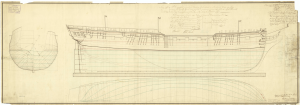This article includes a list of general references, but it lacks sufficient corresponding inline citations. (January 2013) |
 Design of the class
| |
| Class overview | |
|---|---|
| Name | Artois class |
| Operators | |
| Preceded by | Pallas class |
| Succeeded by | Alcmene class |
| Completed | 9 |
| Lost | 5 |
| General characteristics | |
| Type | Frigate |
| Tons burthen | 983 70⁄94 bm (as designed) |
| Length |
|
| Beam | 39 ft 0 in (11.9 m) |
| Depth of hold | 13 ft 9 in (4.19 m) |
| Sail plan | Full-rigged ship |
| Complement | 270 (altered later to 315) |
| Armament |
|
The Artois class were a series of nine frigates built to a 1793 design by Sir John Henslow, which served in the Royal Navy during the French Revolutionary and Napoleonic Wars.
Seven of these ships were built by contract with commercial builders, while the remaining pair (Tamar and Clyde) were dockyard-built – the latter built using "fir" (pitch pine) instead of the normal oak.
They were armed with a main battery of 28 eighteen-pounder cannon on their upper deck, the main gun deck of a frigate. Besides this battery, they also carried two 9-pounders together with twelve 32-pounder carronades on the quarterdeck, and another two 9-pounders together with two 32-pounder carronades on the forecastle.